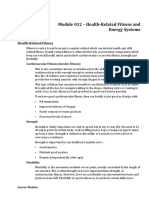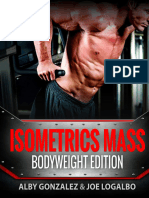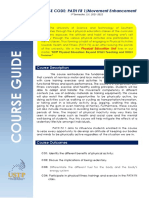PEHreviewer
PEHreviewer
Uploaded by
Dhana kate PerezCopyright:
Available Formats
PEHreviewer
PEHreviewer
Uploaded by
Dhana kate PerezCopyright
Available Formats
Share this document
Did you find this document useful?
Is this content inappropriate?
Copyright:
Available Formats
PEHreviewer
PEHreviewer
Uploaded by
Dhana kate PerezCopyright:
Available Formats
Physical education and health 1 2.
Make heart and lungs strong
Aerobic physical activities 3. Increase edurance and energy level
-often involve large muscle groups 4. Reduce risk to illness
-continious and repetitive in nature 5. Boost immune system and prolong life
-more structured type pf physical activity 6. Reduce feelings of depression and anxiety
7. Improve attention, focus and memory
Walking- most underrated type of exercise 8. Impove sleep
Tips in walking session
1. Upright relax posture
Muscle strengthening exercise for
2. Comfortable and appropriate attire
3. Lower down volume of earphones beginners
4. Invite someone to accompany you Sliding forearm exercise
5. WHO recommends 150-300 minutes per week Chest press
of moderate rigorous activity to maintan body Arm circles
weight. Bone strengthening exercise for
Cycling- form of active transportation beginners
Tips for a safe ride Squat jumps
Avoid loose clothing Jumping oblique twist
Invest in accessories Squat curl overhead press exercise
Apply sunscreen
Consult doctor before engaging
Choose a flat road for beginners
Facts
Follow traffic laws Hiromo Inada
Choose less congested roads -acc. To GBWR, he is the oldest triathlete to
Condition your body compete in the ironman world championship, he
Bicycle friendly communities act is 87 yrs old
The bicycle act of 2016 (house bill 174) and other -required to swim 3.86 km, bike 180.25km, and
bills that push for the establsihment of more bike run 42.19 km
lanes and call for protecting bike enthusiasts. -he started when he was 65 yrs old
Dancing- rhythmic qualities 1. Aging is an inevitable process that affects the
zumba dance- one of the most popular dance body
exercise. People start to engage in dance not only as a 2. Acc. To webMD(2021) body mass starts to
passion but also as means to combat illness. deteriorate at age 30 and can lead to
(hanna, 1995) ostopenia
Zumba is a routine inspired dance exercise by
Alberto Perez Ostopenia- weakening of bone
According to zumba fitness 2012, there are Osteoporosis- makes bone thin and easy to
more than 12m zumba enthusiasts break
Salsa, cha-cha, samba Sarcopenia- skeletal muscles start to
Tips for participating in zumba dance deteriorate
Consider health condition Skeletal muscles- attached to bones
Wear comfortable attire Musculoskeletal system- muscle and bones
Warm up
Do not skip cool down session Muscle and bone strengthening
Choose easy option
Enjoy, have fun, hydrate
activities
A. WEIGHT BEARING ACTIVITIES
Swimming- enhance breathing efficiency
Tips for swimmers Physiological stimulus for more
Enroll in swimming programs metabolism and bone fromation
Commit atleast 3 times a week for exercise Wolfs law- german anatomist and surgeon
Invest in equipments julius wolf
Hydrate If loading on the bone increases, bone
Health benefits will remodel itself to become stronger
1. Burn calories that can lead to weight loss Walking, jogging, dancing, sports
B. RESISTANCE EXERCISE high intensity effort, speed or long
Strengthening training activities that duration physical exertion
make muscle work against a weight of
force Nutrition- plays an importants role in the
Free wights such as dumbells, kettlebells function of energy system of the body
Weigh machine exercise, resistant band 3 major macronutrients
exercise
Body weight exercise such as squats, push Carbohydrates- utilize the fuel moderate
ups to high intensity physical activities
Acc. To Gary Calabrese, in the article “how can Protein- use for body tissue repair and
you avoid muscle lost as you age?” young maintenance
adulthood and middle-aged are the best time Fats- used to power low power, long
toengage in muscle and bone strengthening durayion physical activites
exercise.
Water
Optimizing ones physical activity Hydration before and after exercise is
peroformance essential
8 glasses of water a day
Energy- ability to work
Thr body is composed of 66% water
System- a set of connected things
Do not let thirst take you when to drink water
Food- source of energy -stavros kavouras (2018)
Chemical energy- carbohydrates, fats
Chemical waste- carbon dioxide, water
Exercise, nutrition, and enough rest in
ATP (adenosine triposphate)
managing stress
- energy obtained from the food we intake is
Endorphin- relieve stress
transferred to high energy molecule
Dopamine- can make you feel good
- can be stored in the muscle
-atp stored in muscle can only supply energy for Serotonin- helps reverse the affects of
activities with approx 2-3 seconds of work depression such as loss of appetite and
disrupted sleeping cycles
3 energy system in the body
1. Phospagen system (8-10s) (100m) Tips for good night sleep
Sprinter 6-8 hrs reco sleeping hrs
ATP-CP Avoid energy drink such as caffeine before
High power sleeping
Short duration activites Avoid drinking too much liquid
Ex. Weightliifting, throwing a ball, Good sleepy environment (low-lighted
sprinting room, cool, quiet)
2. Glycogen- lactic acid system
Swimmer (1.3-1.6 mins.) (400m) Food
Anaerobic glycolysis system Food choices are also linked to feeling of
Fuels moderate power tiiredness, loneliness and depression.
Moderate duration physical activities Healthier food can help regulate mood annd
Ex. Cycling, swimming, badminton lower depression, bananas, oats, berries, nuts, seeds,
Sports event fueled by this energy system etc.
3. Aerobic respiration
Marathon runner unlimited time(15 km) The healthy trinity
Aerobic energy system (oxidative -exercise, nutrition, sleep
system)
Low power
-foundation of optimum health
Long-duration physical activities -these components are interrelated
uses mainly carbohydrates and fats to
create energy supply for bodily functions
ex. 3 mile walk and long run
Types of eating
Fueling performance Flexibility
-usually associated with athletes -affected by the structure of the jointand
-eating specific things during specific time
the muscle surrounding the jont.
windows to maximize performace and
recovery Body composition
Emotional eating -total make-up of the body is usually
-propensity to eat in response to positive and divided into fat mass and fat-free mass
-negative emotions (ex. Bone, muscle).
Refers to eating as means of coping
mechanism
Social eating
-People gathering together to accompany
each other while eating
-meeting either at someones place or a
restaurant to enjoy a meal together
Eating while watching tv or sports event
-lead to excess weight gain
-can impact on awareness, attention, memory
and can lead to being distracted
-paying attention to what you eat can keep
you from over eating
Habits
-Unhealthy habits are behavioral patterns that are
performed unconciously
-Hard to break because the brain had been
programmed to make the behavior or action part of
its default setting
Pre contemplation stage
Contemplation stage
Preparation stage
Maintenance stage
Improving fitness is a crucial goal for achieving
optimum health.
Body mass index
-a weight-to-height ratio
BMI=W/H2
Fitness components
Aerobic capacity
-the ablity to deliver and utilize oxygen is
an indicator of a healthy heart.
Muscular strenght
-a good strength level protects an
individual from severe injuries when
he/she falls. It is corelated in bone health.
Example is lifting weights.
Muscular endurance
-the period of tie in which a muscle is able
to hold a contractionreflect the muscles
ability to resist fatigue.
You might also like
- 100 FinishersDocument110 pages100 FinishersLennart100% (3)
- Body BladeDocument1 pageBody BladejoeNo ratings yet
- HSE102 Practical Manual - WordDocument18 pagesHSE102 Practical Manual - WordHello FinesNo ratings yet
- Hope 2 - ReviewerDocument4 pagesHope 2 - Reviewercody haymeNo ratings yet
- Lesson 1 Bone StrengtheningDocument5 pagesLesson 1 Bone StrengtheningJalen MontefalcoNo ratings yet
- Pe&h Q1 NotesDocument10 pagesPe&h Q1 NotesGrinesteinNo ratings yet
- Hope 11 PRELIMDocument8 pagesHope 11 PRELIMKristina PabloNo ratings yet
- Filrang Talumpati Ex.Document2 pagesFilrang Talumpati Ex.frytzmanalo814No ratings yet
- P.E. ReviewerDocument7 pagesP.E. ReviewerPamela Loyola NuestroNo ratings yet
- SPORTS HandoutDocument25 pagesSPORTS HandoutJhoanna Marie Manuel-AbelNo ratings yet
- Pe11 Module-1Document15 pagesPe11 Module-1Gemard JemNo ratings yet
- P E-ReviewerDocument4 pagesP E-Reviewerkentjairusnocete0No ratings yet
- Reviewer in Peh 1 1st QuarterDocument8 pagesReviewer in Peh 1 1st Quarterally100% (1)
- G12 PEH1 Quarter 1 Week 3 4Document9 pagesG12 PEH1 Quarter 1 Week 3 4Shamaica SurigaoNo ratings yet
- Peh LP1-LP2Document6 pagesPeh LP1-LP2Godfrey RetretaNo ratings yet
- Pe and HealthDocument12 pagesPe and HealthJoohyun isabaeNo ratings yet
- Proper Etiquette and Safety in The Use of Facilities and Equipment: Aerobic ExerciseDocument3 pagesProper Etiquette and Safety in The Use of Facilities and Equipment: Aerobic Exerciseanya b.No ratings yet
- Pe and Health ReviewerDocument9 pagesPe and Health ReviewerDimple Cortez-mNo ratings yet
- HOPE Notes 2nd GradingDocument5 pagesHOPE Notes 2nd Gradingcongoh251No ratings yet
- P.E. and Health ReviewerDocument6 pagesP.E. and Health ReviewerBuena QuintinNo ratings yet
- Lesson 1:: Aerobic, Muscle-Strengthening, and Bone-Strengthening ActivitiesDocument6 pagesLesson 1:: Aerobic, Muscle-Strengthening, and Bone-Strengthening ActivitiesJerwin Samson100% (1)
- HOPE1Document11 pagesHOPE1Jupiter Jeffrey R. ReyesNo ratings yet
- Amabern Report P.EDocument3 pagesAmabern Report P.EWinter Summer SmithNo ratings yet
- Throughout The Lesson, The Students Are Expected To:: Movements, Undergone Long Duration of TimeDocument3 pagesThroughout The Lesson, The Students Are Expected To:: Movements, Undergone Long Duration of TimeWinter Summer SmithNo ratings yet
- HOPE1REVIEWERDocument12 pagesHOPE1REVIEWERWilson CadienteNo ratings yet
- Midterms Reviewer P.E.Document3 pagesMidterms Reviewer P.E.PK AdelantarNo ratings yet
- MAPEH Reviewer 4thDocument3 pagesMAPEH Reviewer 4thAngeles, Ladee Maxine T.No ratings yet
- Reviewer in Pe and HealthDocument16 pagesReviewer in Pe and HealthJean DaclesNo ratings yet
- Hope ReviewerDocument4 pagesHope ReviewerPat ChuNo ratings yet
- SPORTS HandoutDocument16 pagesSPORTS HandoutBobong blyatNo ratings yet
- Peh 3 1ST Grading ReviewerDocument4 pagesPeh 3 1ST Grading ReviewerTodo RokiNo ratings yet
- P.E 1 Hand Outs 1quarterDocument9 pagesP.E 1 Hand Outs 1quarterArlyn S. Jumao-asNo ratings yet
- HOPE NotesDocument6 pagesHOPE Notesayaka kamisatoNo ratings yet
- PE Reviewer 2nd SemDocument13 pagesPE Reviewer 2nd SemMartires, Vea Janela P.No ratings yet
- P E - 1-ReviewerDocument2 pagesP E - 1-ReviewerAlejandro Peralta IIINo ratings yet
- Assessment Task Title: Short Answer Questions and Case Study Assessment Conditions: The Questions Can Be Completed in Own TimeDocument4 pagesAssessment Task Title: Short Answer Questions and Case Study Assessment Conditions: The Questions Can Be Completed in Own TimeGabrielNo ratings yet
- Hope 2 - ReviewerDocument3 pagesHope 2 - ReviewerYianna SibayanNo ratings yet
- Health-Related Fitness Training PrinciplesDocument1 pageHealth-Related Fitness Training PrinciplesMariah FongheNo ratings yet
- GRADE 11 PE MODULE 1st QuarterDocument33 pagesGRADE 11 PE MODULE 1st QuarterDan Paulo BarandaNo ratings yet
- Prelim-Midterm ReviewerDocument67 pagesPrelim-Midterm ReviewerJohn Delf GabrielNo ratings yet
- PATHFIT TRANSES UNIT III and IVDocument3 pagesPATHFIT TRANSES UNIT III and IVMERAZOLE PACA-ANASNo ratings yet
- Energy System and Dance StressDocument44 pagesEnergy System and Dance StressJohn ZanderNo ratings yet
- P E-ReviewerDocument4 pagesP E-ReviewerCee Jay GerongcoNo ratings yet
- Pathfit 2 ReviewerDocument8 pagesPathfit 2 ReviewerAdrian PrinceNo ratings yet
- Week 016-Module 016-Health Related Fitness and Energy SystemsDocument4 pagesWeek 016-Module 016-Health Related Fitness and Energy SystemsRouie john dizonNo ratings yet
- Hope 1 ReviewerDocument3 pagesHope 1 ReviewerJOHN CARLO L. DESTACAMENTONo ratings yet
- First Asian International Systems College, Inc.: Senior High School DepartmentDocument9 pagesFirst Asian International Systems College, Inc.: Senior High School DepartmentMikee Marcelo0% (1)
- Physical Education and Health ReviewerDocument4 pagesPhysical Education and Health ReviewerJay-mee Claire V. DioNo ratings yet
- Pathfit 2 Reviewer.Document13 pagesPathfit 2 Reviewer.Karl Joshua B. TauroNo ratings yet
- Consider Four Basic Food GroupsDocument3 pagesConsider Four Basic Food GroupsPrecious ViterboNo ratings yet
- TK - V2Document80 pagesTK - V2Lucía IcasattiNo ratings yet
- Hope 1.physical Fitness 2Document12 pagesHope 1.physical Fitness 2Aleck Celeres100% (1)
- Pe ExamDocument4 pagesPe ExamJouhara ObeñitaNo ratings yet
- Reviewer PeDocument5 pagesReviewer PeCamille PanaliganNo ratings yet
- Reviewer PE 1st QuarterDocument6 pagesReviewer PE 1st QuarterChristian MasurcaNo ratings yet
- HPR Notes Aerobiclecture PDFDocument14 pagesHPR Notes Aerobiclecture PDFJerico SantosNo ratings yet
- Pe - Health Q3 ReviewerDocument3 pagesPe - Health Q3 ReviewerKarel Cyra CallorinaNo ratings yet
- Class 12 UNIT - 7 NOTESDocument10 pagesClass 12 UNIT - 7 NOTESAyaan InamdarNo ratings yet
- HOPE 1 - Quarter 1 - Hand OutsDocument5 pagesHOPE 1 - Quarter 1 - Hand Outsjrezecordero12No ratings yet
- The Exercise ProgramDocument3 pagesThe Exercise ProgramMinaNo ratings yet
- Physical Education 1 NotesDocument3 pagesPhysical Education 1 Notesbalbutin.marycarmelNo ratings yet
- How to Lose Weight Jumping Rope Like a Boxer & ToneUp, Get Fit and Feel Great!From EverandHow to Lose Weight Jumping Rope Like a Boxer & ToneUp, Get Fit and Feel Great!No ratings yet
- Atif's ResumeDocument1 pageAtif's ResumePraveen MalhhotraNo ratings yet
- 37 Well-Being-British-English-StudentDocument7 pages37 Well-Being-British-English-StudentBIANCA SILVA(116470)-FNo ratings yet
- Goku 4week Lean Bulk ProgramDocument12 pagesGoku 4week Lean Bulk ProgramAditya SanjeevNo ratings yet
- EssayDocument2 pagesEssaycheNo ratings yet
- Lesson 2:: Personal Fitness ProgramDocument4 pagesLesson 2:: Personal Fitness ProgramJerwin Samson0% (1)
- The 12 Week Lean Muscle ProjectDocument63 pagesThe 12 Week Lean Muscle ProjectNelson LopesNo ratings yet
- Pooch To 5 K TimedDocument2 pagesPooch To 5 K Timed哲学森の妖精No ratings yet
- Isometrics Mass Bodyweight EditionDocument44 pagesIsometrics Mass Bodyweight EditionfgquinonezNo ratings yet
- Peoplewhohatemornings InteractiveDocument5 pagesPeoplewhohatemornings Interactivelorena jimenezNo ratings yet
- Course Guide in PATH Fit 1 1st Sem AY 2021 2022 1Document5 pagesCourse Guide in PATH Fit 1 1st Sem AY 2021 2022 1James Loyed Tabasan100% (2)
- Isometric ExercisesDocument5 pagesIsometric ExercisesScribdTranslationsNo ratings yet
- 10-Day Original Strength + Bodyweight Hybrid Challenge: by Aleks "The Hebrew Hammer" SalkinDocument13 pages10-Day Original Strength + Bodyweight Hybrid Challenge: by Aleks "The Hebrew Hammer" SalkinCharles Mitchell100% (1)
- RSG Beginner and Intermediate 5K ProgramDocument37 pagesRSG Beginner and Intermediate 5K ProgramIman Saiful100% (2)
- Pe100 M1Document31 pagesPe100 M1Aishah SangcopanNo ratings yet
- The Fundamentals of Bodybuilding and Physique Sculpting (Mod)Document34 pagesThe Fundamentals of Bodybuilding and Physique Sculpting (Mod)Junior Vickers100% (1)
- UNIT - 6: Test & Measurement in Sports..!! Along-With Important QuestionsDocument68 pagesUNIT - 6: Test & Measurement in Sports..!! Along-With Important QuestionsMahima Famous100% (1)
- Tabata Exercise Pe 1Document1 pageTabata Exercise Pe 1Joshua Jae AquinoNo ratings yet
- Pe 11 - Path-Fit 1Document6 pagesPe 11 - Path-Fit 1Christian Angelo SoretaNo ratings yet
- GI B1 U3 Grammar StandardDocument1 pageGI B1 U3 Grammar StandardAgustina LerchundiNo ratings yet
- Summative Pe & HealthDocument2 pagesSummative Pe & HealthLyra Lyn R BaniquidNo ratings yet
- Barbell Complex WorkoutDocument6 pagesBarbell Complex Workouttomek.michalikNo ratings yet
- FBB CardioDocument4 pagesFBB Cardionikos100% (1)
- Menopause Muscle BuilderDocument1 pageMenopause Muscle Builderelgato2224No ratings yet
- St. Vincent of Quebiawan Integrated School Division Quality Assured Sipacks For Mapeh 8 QUARTER 2 - Week 5Document9 pagesSt. Vincent of Quebiawan Integrated School Division Quality Assured Sipacks For Mapeh 8 QUARTER 2 - Week 5Juliana Bea SingsonNo ratings yet
- Powerbuilding Breakdowns (2021) - Libgen - LiDocument73 pagesPowerbuilding Breakdowns (2021) - Libgen - LiTony Balado100% (3)
- Basketball Module g11 PE L5Document9 pagesBasketball Module g11 PE L5Rafael AnianoNo ratings yet
- Sas #13 Ped 025Document5 pagesSas #13 Ped 025CRYPTO KNIGHTNo ratings yet

























































































